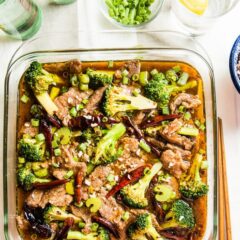
Authentic Szechuan Poached Beef (水煮牛肉)
Just like real Szechuan food, the beef and broccoli are cooked in a very rich sauce that contains numerous herbs, peppers, and hot oil to create the most scrumptious flavor. The beef is melt-in-your-mouth tender. The numbing spiciness is so addictively good that you cannot stop eating, even if it makes your stomach burn!
Ingredients
Beef marinade
- 2 pieces (1 pound / 440 grams) total beef short ribs (or sirloin, or tenderloin)
- 2 tablespoons soy sauce
- 2 tablespoons Japanese sake (or Shaoxing wine)
- 2 tablespoons cornstarch
For cooking
- 1 head broccoli , cut into bite sized pieces
- 1 stalk celery , chopped
- 5 stalks green onion , chopped
- 4 big cloves garlic , minced
- 1/2 cup peanut oil (or vegetable oil)
- 30 1/2 cup chili peppers , dried
- 1 and 1/2 tablespoons Szechuan peppercorns
- 3 tablespoons spicy fermented bean paste doubanjiang
- 1 tablespoon Japanese sake (or Shaoxing wine)
- 1 tablespoon soy sauce
Instructions
- Slice beef thinly against the grain into bite sized pieces.
- Combine beef, soy sauce and sake in a large bowl. Mix well.
- Add cornstarch and mix thoroughly by hand, until all the beef slices are coated with a thin layer of starch.
- Prep and chop veggies, green onion, and garlic. Transfer the white part of the green onion and half of the garlic to a small bowl. Transfer the rest of the green onion and the rest of the garlic to another small bowl.
- Bring 1 liter water to a boil. Set aside.
- Add 2 tablespoons oil into a large skillet (or wok). Heat over low heat until the oil is warm. Add peppercorn and chili pepper. Cook and stir constantly, until the pepper turns dark reddish brown, 3 to 4 minutes. (*See footnote 1)
- Add spicy fermented bean paste. Cook and stir for 1 minute.
- Add the mixture of green onion (white part) and garlic. Stir and cook for 30 seconds.
- Add 1 tablespoon soy sauce and 1 tablespoon Shaoxing wine. Stir and cook for about 30 seconds.
- Add the 1 liter hot water and turn to medium high heat.Bring to a boil.
- (Optional) Use a strainer to remove all the chili peppers and Sichuan peppercorns (*See footnote 2).
- Add broccoli and celery. Cook for 1 minute, until the veggies are half cooked through. Transfer all the veggies to a big serving dish or bowl. (*See footnote 3)
- Bring broth to a boil.
- Cook half the beef slices first. (*See footnote 4) Add slices into the broth piece by piece. Wait until the beef is just cooked, about 1 minute. Immediately use tongs and a strainer to transfer all the beef to the serving dish, on top of the broccoli and celery. (*See footnote 5) Continue to cook the rest of the beef in the same way and transfer it to the serving plate.
- Heat the rest of the oil (slightly more than 1/4 cup) in a small skillet until it just starts to smoke (or reaches 430 degrees F/ 220 C). Remove oil from heat immediately (*See footnote 6).
- Pour the spicy broth into the serving bowl first, to the point where it almost covers the beef (the top layer of beef should not be covered).
- Spread the rest of the green onion (green part) and garlic on top of the beef.
- Carefully and slowly drizzle hot oil on top of all the garlic and green onion. You should hear a vibrant sizzling and the oil should bubble fiercely. Let cool for 5 to 10 minutes.
- Serve warm with steamed rice.
Notes
- If you’re using a gas stove, it might take less time to cook the peppers. Make sure to watch them closely and do not let the peppers turn too dark. When the peppers turn from reddish dark brown to almost black, they’re burnt and will create a bitter flavor.
- In traditional Chinese cooking, the chili peppers and peppercorns won’t be removed. After serving the dish, you’ll need to pick out the peppers as you eat. If you’re not comfortable with the traditional way, remove the peppers and peppercorns at this stage.
- The veggies will continue cook after the hot broth is added to the serving dish. It’s ok that the broccoli is still a bit tough at this point.
- By cooking beef in smaller batches, you ensure the temperature of the broth doesn’t drop too low. The best way to cook tender, juicy beef is to cook it quickly in boiling broth.
- It is fine to transfer the beef to the plate even if it still looks a bit pink. In the last steps, the hot broth and oil will continue to cook the beef.
- This is the most important part and do not skimp on the oil. The hot oil will cook the raw garlic and green onion to create a great aroma. You will need a layer of oil on top of the dish, so when you pick up a piece of beef while eating, it will be coated with a thin layer of delicious herb-infused oil. It may seem like you’re using a lot of oil, but you will only consume a small fraction of it when eating.
Nutrition
Serving: 318g, Calories: 519kcal, Carbohydrates: 23.2g, Protein: 46g, Fat: 27.5g, Saturated Fat: 6.2g, Cholesterol: 119mg, Sodium: 1244mg, Potassium: 987mg, Fiber: 4.6g, Sugar: 6.6g, Vitamin A: 1400IU, Vitamin C: 121.3mg, Calcium: 70mg, Iron: 26.6mg